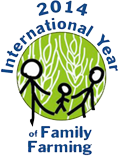Making Agriculture “Cool” for Youth

Agriculture has an image problem. Simply put, for the majority of the world’s youth, agriculture simply isn’t seen as being “cool” or attractive. Most think of it only as back-breaking labor, without an economic pay-off—and little room for career advancement.
With an ageing population of farmers, it’s clear that agriculture needs to attract more young people. This is a global challenge: half the farmers in the United States are 55 years or older, while in sub-Saharan Africa, the average age of farmers is around 60 years old.
“The exodus of rural youth means fewer small-scale farmers tomorrow, potentially drastically changing the profile of farming,” according to a recent report by the International Institute for Environment and Development (IIED).
The U.N. International Labour Organization predicts that, globally, there will be 74.2 million unemployed young people this year, an increase of 3.8 million since 2007. Youth unemployment is both a threat and an opportunity. The agricultural sector offers huge potential for job creation. Realizing this can radically change the image of agriculture among young people.
And agriculture’s image among young people is changing—from Brooklyn, New York to Nairobi, Kenya—where youth are now turning to farming and the food system as a viable career path.
“Increased access to education and new forms of agriculture-based enterprise mean that young people can be a vital force for innovation in family farming, increasing incomes and well-being for both farmers and local communities. Young people can transform the agricultural sector by applying new technologies and new thinking” said Mark Holderness, Executive Secretary of the Global Forum for Agricultural Research (GFAR).
Agriculture means more than subsistence farming-- today, young people can explore career options in permaculture design, biodynamic farming, communication technologies, forecasting, marketing, logistics, quality assurance, urban agriculture projects, food preparation, environmental sciences, advanced technologies, and more.
Farmers, businesses, policy-makers, and educators need to promote agriculture as an intellectually stimulating and economically sustainable career—and make jobs in the agriculture and food system “cool” for young people all over the world.
A resurgence of interest among young farmers is happening and it’s vital to support this growth.
In collaboration with GFAR, Food Tank has compiled an exciting list of organizations working with young people around the world to make agriculture and agriculture-related work more appealing and change public perceptions so that agriculture is not just seen as cool, but is recognized as a vitally important career.
In the United States, the New Entry Sustainable Farming Project works to strengthen local food systems by supporting new farmers. The farmer training program helps young farmers learn what it takes to run a small farm operation from business planning to specialized advanced workshops in livestock and healthy food.
And in southeastern New England, the Young Farmer Network hosts “Young Farmer Night,” a series of free regular social and educational events that bring farmers of all ages and experience levels together to network and collaborate.
U.S. Agriculture Deputy Secretary Krysta Harden recently announced resources and policy changes to improve the financial security of new and beginning farmers and ranchers. This includes a new website that will be a one-stop resource where farmers and ranchers can explore the variety of U.S. Department of Agriculture (USDA) initiatives designed to help them succeed.
Last year in Africa, Joseph Macharia started a Facebook page, “Mkulima Young,” to encourage youth to engage in agriculture. The page serves as a social forum for youth, a place to ask questions, and create agriculture networks. Macharia posts photos and inspirational stories of farmers to empower youth in his community.
In Kenya, Uganda, Antigua, and Barbuda the Junior Farmer Field and Life Schools (JFFLS) foster market demand for sustainable food while also providing youth with tools to begin growing their own sustainable food. JFFLS goal is to empower vulnerable youth and provide them with skills needed for long-term food security.
Farm Africa began a farm training program for rural youth, growing vegetables, mushrooms, and passionfruit in Ethiopia, Kenya, South Sudan, Tanzania, and Uganda. They teach students how to get the best price at market and encourage them to get involved in local governance.
The European Council of Young Farmers (CEJA) is the “voice of Europe’s next generation of farmers.” CEJA’s main objective is to support the renewal of generation in the agriculture sector by being a platform for information and education exchange.
The International Movement of Catholic Agricultural and Rural Youth (MIJARC) has two million young rural people as members, contributing to and promoting the sustainable development of agricultural and rural areas all over the world, to make rural areas attractive and viable for young people.
The Caribbean Farmers Network (CaFAN) began a new program of training, capacity building, and promoting young farmer-leaders under age 35 in Trinidad, Tobago, Guyana, Antigua, Grenada, St. Lucia, Barbados, and St. Vincent. Fifteen of the participants have started blogs to share ideas and opinions on the agriculture sector including, Nyamekye Mapp of Tobago, and her search for agrifootsoldiers.
The International Fund for Agricultural Development (IFAD) Rural Youth Talents Program in South America seeks to publicize and share knowledge from lessons learned in rural youth agriculture programs. The goal is to establish and strengthen networks of youth involved in food and agriculture, as well involve more youth in the field.
The South Asia Youth Camp on Agriculture and Water mobilizes youth between ages 18 and 36 to influence government leaders to take action on climate change and responsibility for agriculture and water. The camp brings together youth to share opinions, ideas, take action, and protect the rights of smallholder producers in South Asia.
And education is changing too:
The Global Confederation of Higher Education Associations in Agriculture and Life Sciences (GCHERA) brings together over 600 agricultural universities, involving around a million students per year. GCHERA is working to change university curricula around the world, to make agriculture-based courses more attractive to young people and more relevant to the skills and opportunities they now seek.
The Earth University in Costa Rica works to prepare future leaders with ethical values to contribute to the sustainable development of the tropics. Their courses include both work experience sessions and students developing and running their own agribusinesses through the class.
Wageningen University in the Netherlands has, over the last decade, completely redefined its courses to meet the needs and priorities of today’s young people. Wageningen now focuses on the theme ‘healthy food and living environment’ and works closely together with both governments and the business community.
And Young Professionals for Agricultural Development (YPARD) is an international movement of nearly 8,000 young professionals, a vibrant network, both online and on the ground, inspiring young people into a wide range of agriculture careers and to play active roles for innovative agricultural development.
The Asia-Pacific Association of Agricultural Research Institutions (APAARI) has organized dialogues, with national and international partners, to explore the challenges, opportunities and requirements for creating attractive agricultural research careers for young professionals in India and Pakistan.
These projects and many other initiatives, programs, and people are making agriculture cool again. What programs do you know about that are making agriculture more appealing to younger generations? Let us know!
Photo credit: ©FAO/Riccardo Gangale
Posted also on Food Tank



